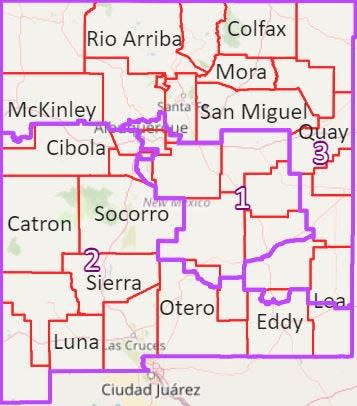New Mexico gerrymandering trial starts this week. Here's what to know about the case.
- Oops!Something went wrong.Please try again later.
- Oops!Something went wrong.Please try again later.
Republicans accused New Mexico’s Democratic Party of purposely sabotaging the GOP’s ability to hold a congressional seat in the state’s southern district, typically a conservative stronghold.
That’s why the GOP sued its opposing party, including Gov. Michelle Lujan Grisham and Secretary of State Maggie Toulouse Oliver, alleging partisan “gerrymandering” when New Mexico’s three congressional districts were redrawn following the 2020 Census.
A three-day bench trial on the matter was set to begin Sept. 27 in Courtroom 402 of the Lea County District Court in Lovington before Ninth Judicial District Judge Fred Van Soelen of Curry County, after district judges in Lea and Eddy counties were recused.
More: 'Gerrymandering' lawsuit against New Mexico Democrats delayed ahead of trial

Here’s what to know about the Republican Party of New Mexico’s gerrymandering case.
What sparked the GOP’s gerrymandering complaint?
The new map altered the boundaries of the Second Congressional District, mixing in parts of Albuquerque with the deep-red southeastern region, and splitting Hobbs between the district and New Mexico’s Third Congressional District.
This change was why, according to the GOP, Democrat Gabe Vasquez was able to defeat incumbent Republican Yvette Herrell by a razor-thin margin in 2022.
While New Mexico’s First and Third congressional districts typically lean left, the Second District was typically Republican ahead of Vasquez’s election.
More: New Mexico GOP's 'gerrymandering' case will proceed after Democrat arguments rejected
The seat was held by Republican Steve Pearce, who now serves as chair of the New Mexico Republican Party, from 2002 to 2018 when he opted to step down and ran unsuccessfully for governor against Lujan Grisham.
Democrat Xochitl Torres Small defeated Herrell that year, but Herrell won the seat in 2020 before losing to Vasquez last year.
What are Republicans hoping to achieve in the case?
If Republicans are successful in their lawsuit, the court will find that Democrats did indeed commit gerrymandering unfairly.
More: Gabe Vasquez wins race for New Mexico's 2nd congressional district
This could lead to the redistricted map being vacated, potentially reverting back to the previous map that could give the GOP the advantage in races for the Second Congressional District.
Who are the parties in the case?
Lujan Grisham and Toulouse Oliver are listed as defendants, along with State Senate Majority Leader Mimi Steward and former-Speaker of the House Brian Egolf.
The Democratic Party of New Mexico was listed as an intervening defendant in the case.
More: Redistricting complete in New Mexico after Gov. Lujan Grisham approves senate map changes
The Republican Party of New Mexico was listed as plaintiff, along with New Mexico Sen. David Gallegos of Eunice, several other local politicians in southeast New Mexico including Roswell Mayor Timothy Jennings.

The Lea County Board of County Commissioners was an intervening plaintiff.
What kind of guidance has the New Mexico Supreme Court issued?
On Friday, the State Supreme Court issued an opinion that the district court could hear the matter, following its ruling in August to send the case to Lea County.
More: City of Carlsbad and Eddy County raise concerns over redistricting maps
In its opinion, the Supreme Court said state courts can rule on gerrymandering claims under the Equal Protection Clause of the New Mexico Constitution, as they have a duty to protect voter rights.
The Court also said that “some degree of partisan gerrymandering is permissible,” although gerrymandering that is “excessively partisan” can dilute the vote and violate voter rights.
How will the court decide of ‘egregious’ gerrymandering took place?
The court must use a three-part analysis of the redistricting to determine if gerrymandering took place to an illegal degree.
First, plaintiffs must prove the redistricting was intended to maintain the power of a political party by diluting the vote of the opposing party.
The GOP also has to prove its vote was indeed diluted by the redistricting.
If the first two parts are proven, the defendants then must fail to show there was an adequate reason for the redistricting for the court to rule in favor of the plaintiffs.
Adrian Hedden can be reached at 575-628-5516, achedden@currentargus.com or @AdrianHedden on X, formerly known as Twitter.
This article originally appeared on Carlsbad Current-Argus: Here's what to know about the New Mexico gerrymandering case
